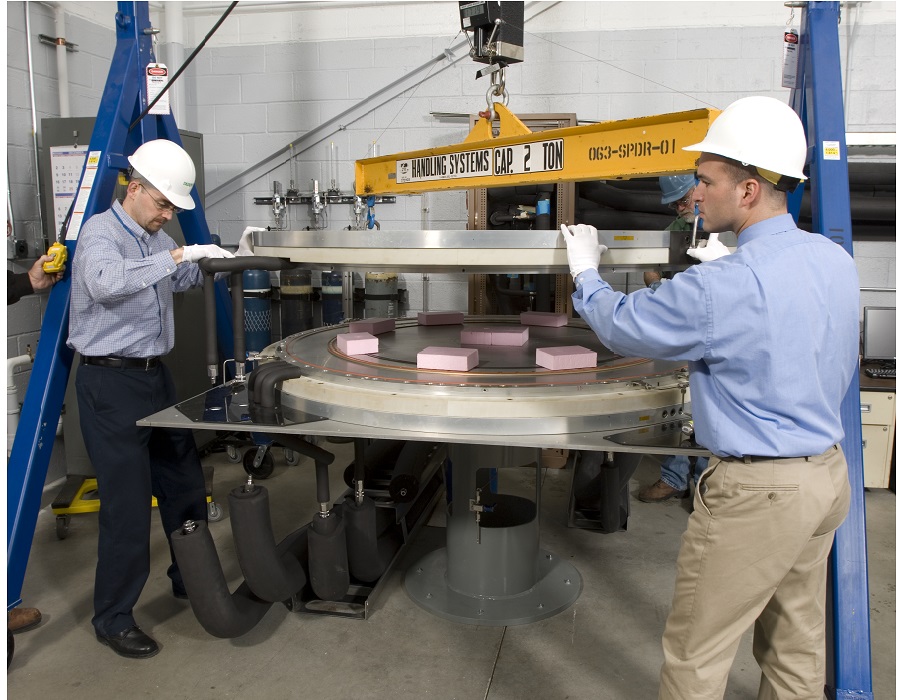On May 30, the United States made history by launching its first crewed spacecraft since 2011. Almost 19 hours later, the SpaceX Crew Dragon space capsule docked to the International Space Station and NASA astronauts Bob Behnken and Doug Hurley safely made their way aboard the space station. The University of Akron (UA) played a vital role — one that began 15 years ago — in this mission that included sending the first privately owned and operated spacecraft into orbit.
For any spacecraft to successfully dock to the space station 250-plus miles above Earth, unique docking hardware is required. Many of the space station’s partners contributed to a design that enables different spacecraft to dock to the orbiting laboratory. The standard docking hardware includes a critical elastomer seal to keep breathable oxygen inside the spacecraft and space station so the astronauts can safely transfer themselves and cargo.
Nearly 15 years ago, NASA recognized that it needed a new seal design for its new docking system, so it contracted with UA, the University of Toledo, Parker Hannifin, Vantage Partners and the Ohio Aerospace Institute to develop a robust seal for NASA and its partners. The seal that could meet the new requirements was first conceptualized by Dr. Christopher Daniels, now an associate professor of mechanical engineering practice at UA.
“I was excited to be able to contribute to manned space travel,” says Daniels. “When the project started, we had no idea the seal’s first crewed mission would have the importance it has today.”
The seal is approximately four feet in diameter and is made to fit around the tunnel the astronauts use to move between the Dragon space capsule and the space station. It must be able to be squeezed with a limited amount of latching strength from the docking system and must not be too tacky, no matter how long it stays connected. The seal has to be able to survive in the cold vacuum of space. And, of course, the seal can’t leak. The goal is to limit leakage to no more air per day than would fill a small coffee can.
"We began by investigating different materials that would survive the harsh space environment.” says Daniels. “Very early on in the project, we ran tests on seals the size of a penny. As the tests became more complicated, the size of the test seals grew larger. We demonstrated full-size seals in conditions that represented the environment in which spacecraft fly.”

Nicholas Penney (left) of the Ohio Aerospace Institute and Christopher Daniels, Ph.D. of UA are assembling a test to measure the leak rate of the full-scale seal at the extremes of the operational temperature range (-40 to +122 degree Fahrenheit). Photo credit: NASA
The team conducted more than 1,000 tests to demonstrate the design could meet NASA’s requirements.
“We had to demonstrate that the seal could work over a wide range of temperatures,” says Daniels. “We showed the seal would work after traveling to the space station and after being exposed to elements encountered in space. We also worked with NASA to prove the seal wouldn’t stick to the space station when a spacecraft would separate from the space station.”
Daniels was supported by UA faculty and staff members Dr. Heather Oravec, a mechanical engineering research professor; Janice Mather, senior research engineer; Dr. Nicholas Garafolo, associate professor of mechanical engineering; Dr. Minel “Jack” Braun, distinguished professor of mechanical engineering, and a number of intern and cooperative education students.
The seal was first launched into space in March 2019 on SpaceX’s uncrewed Demo-1. Smaller seal prototypes have previously been launched into space, including ones that were affixed to the space station for 18 months. These prototypes were exposed to space’s elements and brought back for testing to confirm the materials stood up to the rigors of space.
SpaceX’s Crew Dragon capsule launched from NASA’s Kennedy Space Center on the same launchpad that blasted the crew of Apollo 11 to the surface of the moon nearly 51 years ago. Astronauts Behnken and Hurley are expected to remain on the space station for six weeks to four months to help with research alongside a NASA astronaut and two Russian cosmonauts who were sent to the space station in April via Russia’s Soyuz MS-16 spacecraft.
Media contact: Alex Knisely, 330-972-6477 or aknisely@uakron.edu.
